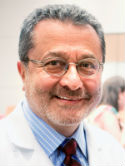Fludarabine-based conditioning secures engraftment of second hematopoietic stem cell allografts (HSCT) in the treatment of initial graft failure Journal Article
| Authors: | Chewning, J. H.; Castro-Malaspina, H.; Jakubowski, A.; Kernan, N. A.; Papadopoulos, E. B.; Small, T. N.; Heller, G.; Hsu, K. C.; Perales, M. A.; van den Brink, M. R. M.; Young, J. W.; Prockop, S. E.; Collins, N. H.; O'Reilly, R. J.; Boulad, F. |
| Article Title: | Fludarabine-based conditioning secures engraftment of second hematopoietic stem cell allografts (HSCT) in the treatment of initial graft failure |
| Abstract: | Graft failure is associated with a high mortality rate. To date, regimens invoked for second transplants have resulted in inconsistent engraftment with high transplant-related mortality (TRM). We here report 16 consecutive patients, aged 4-59 years, who received second HSCT (HSCT-2) at a median of 45 days following primary or secondary failure of an initial unmodified (N = 3) or T cell-depleted (TCD) (N = 13) HSCT (HSCT-1). HSCT-1 was administered after myeloablative total body irradiation (TBI)- or alkylator-based conditioning for acute leukemias (N = 7), MDS (N = 6), CML (N = 2), and Fanconi anemia (N = 1). All patients experienced 1 or more infectious complications between HSCT-1 and HSCT-2, and 10 patients had active infections at the time of HSCT-2. Cytoreduction regimens used for HSCT-2 included fludarabine (Flu) in combination with cyclophosphamide (CTX) (N = 9), or thiotepa (Thio) (N = 5). In addition, 1 patient received Flu alone and 1 patient Thio combined with CTX. Antithymocyte globulin (ATG) (N = 11) or Alemtuzumab (N = 3) was added pretransplant to prevent rejection. For HSCT-2, donors included HLA-matched (N = 3) or mismatched (N = 8) related, or matched (N = 2) or mismatched (N = 3) unrelated donors. The primary graft donor was used in 6 of 16 cases. The grafts administered were unmodified peripheral blood stem cell transplantation (PBSCT) (N = 5) or bone marrow transplantation (BMT) (N = 3), TCD PBSCT (N = 8). All patients achieved engraftment at a median of 12 days and evaluable patients achieved complete donor chimerism. Six patients are alive with a median follow-up of 49 months, including 4/9 conditioned with Flu/CTX. In this series, outcome was statistically superior for younger patients (≤20 years). In summary, second HSCT using the combination of a fludarabine- and ATG-based, nonmyeloablative regimen and higher numbers of CD34+ progenitor cells has been associated with acceptable toxicity and allowed consistent engraftment with hematopoietic reconstitution in patients with previous graft failure. © 2007 American Society for Blood and Marrow Transplantation. |
| Keywords: | adolescent; adult; cancer survival; child; clinical article; child, preschool; middle aged; retrospective studies; busulfan; fludarabine; salvage therapy; drug dose reduction; monotherapy; methotrexate; outcome assessment; follow up; cd34 antigen; infection; combination chemotherapy; cyclophosphamide; melphalan; steroid; allogenic bone marrow transplantation; hematopoietic stem cell transplantation; chronic myeloid leukemia; thiotepa; high risk patient; kaplan-meiers estimate; chimera; acute leukemia; engraftment; graft failure; hla matching; myeloablative conditioning; myelodysplastic syndrome; nonmyeloablative conditioning; whole body radiation; statistical significance; drug therapy, combination; graft versus host reaction; transplantation conditioning; allogeneic hematopoietic stem cell transplantation; living donor; age distribution; graft rejection; graft survival; t cell depletion; immunosuppressive treatment; cyclosporin a; tacrolimus; cd34 selection; cyclosporin; immunosuppressive agents; alemtuzumab; vidarabine; thymocyte antibody; aplastic anemia; fanconi anemia; infectious complication; chimerism; hematopoietic stem cell transplant; allogeneic peripheral blood stem cell transplantation; antilymphocyte serum; leukocyte reduction procedures |
| Journal Title: | Biology of Blood and Marrow Transplantation |
| Volume: | 13 |
| Issue: | 11 |
| ISSN: | 1083-8791 |
| Publisher: | Elsevier Inc. |
| Date Published: | 2007-11-01 |
| Start Page: | 1313 |
| End Page: | 1323 |
| Language: | English |
| DOI: | 10.1016/j.bbmt.2007.07.006 |
| PUBMED: | 17950918 |
| PROVIDER: | scopus |
| DOI/URL: | |
| Notes: | --- - "Cited By (since 1996): 17" - "Export Date: 17 November 2011" - "CODEN: BBMTF" - "Source: Scopus" |
Altmetric
Citation Impact
BMJ Impact Analytics
MSK Authors
-
 14
14Chewning -
 512
512Kernan -
 234
234Small -
 329
329Boulad -
 400
400Heller -
 262
262Prockop -
 618
618Van Den Brink -
 420
420Papadopoulos -
 459
459Jakubowski -
 945
945Perales -
 187
187Hsu -
 320
320Young -
 333
333Castro-Malaspina -
 748
748O'Reilly -
 90
90Collins
Related MSK Work


